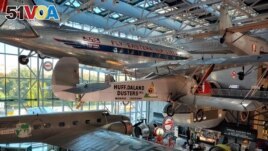24 October 2022
The popular National Air and Space Museum in Washington, D.C. has partly reopened. The museum had been closed for almost seven months.
It now has eight new exhibitions, hundreds of new artifacts, and 50 digital interactive exhibits. Among the exhibits are The Wright Brothers and the Invention of the Aerial Age and Exploring the Planets.
The museum built digital interactive exhibits to make it more modern and interesting for visitors.

The America by Air exhibition traces the history of air transportation in the United States. In the early 20th century, there were few airports or airlines. By the end of the century, passengers could travel almost anywhere in the US in hours. (Deborah Block/VOA)
"It's an experience that reflects the 21st century, bringing people into the digital age," said Jeremy Kinney. He is the museum's associate director for research and for curatorial affairs, which is how objects are preserved and shown to the public.
The new exhibits include an interactive tour of the solar system.
"The planets gallery is a fully immersive journey through our solar system, stopping at different locations, and seeing what that looks like on a large scale," Kinney said. "You learn about the surface of different planets and asteroids. It almost feels like you're walking on them."
Eighteen-year-old Taylor Brautigan recently visited the museum.
"It was fantastic to see how different the planets are, and it made me want to find out more about them," she said.
Exhibits tell stories
Visitors can see favorite object in new displays that tell interesting stories.
They include the 1903 Wright Flyer, the first powered and piloted mechanical aircraft.
Ahmed Chaudry had traveled from Pakistan to visit relatives in Washington. He said he had looked forward to seeing the aircraft.
"The exhibit explains the background behind the Wright Brothers and what they went through to build the plane," he said. "They only flew it for 12 seconds the first time, but it was incredible they were able to do that."
The Destination Moon exhibit shows well-known artifacts from space history, including the Apollo 11 command module, Columbia, and the spacesuit astronaut Neil Armstrong wore during the journey to the moon in 1969.
Armstrong was the first man to walk on the moon.
Including more women and people of color
More important work by women and people of color are presented than were in the past.
These include the air racer built by Neal Loving, the first African American to be licensed as a racing pilot, and a supersonic jet trainer flown by Jackie Cochran. She was the first woman to fly faster than the speed of sound.
The museum also describes the discrimination they faced, however.
"Our goal is to tell the whole history of air and space which also includes gender and race discrimination," said Kinney.
That includes women who qualified for but were denied entry into the space program. The museum also explains that Black people were permitted on commercial passenger planes but not in some airports because of the color of their skin.
The rest of the museum is set to open in 2025.
I'm Andrew Smith.
Deborah Block wrote this story for Voice of America. Andrew Smith adapted it for VOA Learning English.
______________________________________________________________________
Words in This Story
exhibition –n. a public event at which objects of interest are displayed, for example at a museum or art gallery.
artifact –n. an object of historical or cultural significance
interactive -adj. describing objects such as a video game or a display in which the user can control, manipulate, or respond to stimuli.
convert –v. to change something into a different form or use
reflect –v. to show or display what something is like
tour –n. a trip or visit to places that interest you
gallery –n. a space used for exhibitions of works of art
immersive -adj. engaging all of the senses and absorbing one's attention
scale –n. the size of something
fantastic -adj. great, wonderful, very good
background –n. the history and information about a person or situation
gender –n. identity as male or female in relation to social and cultural roles